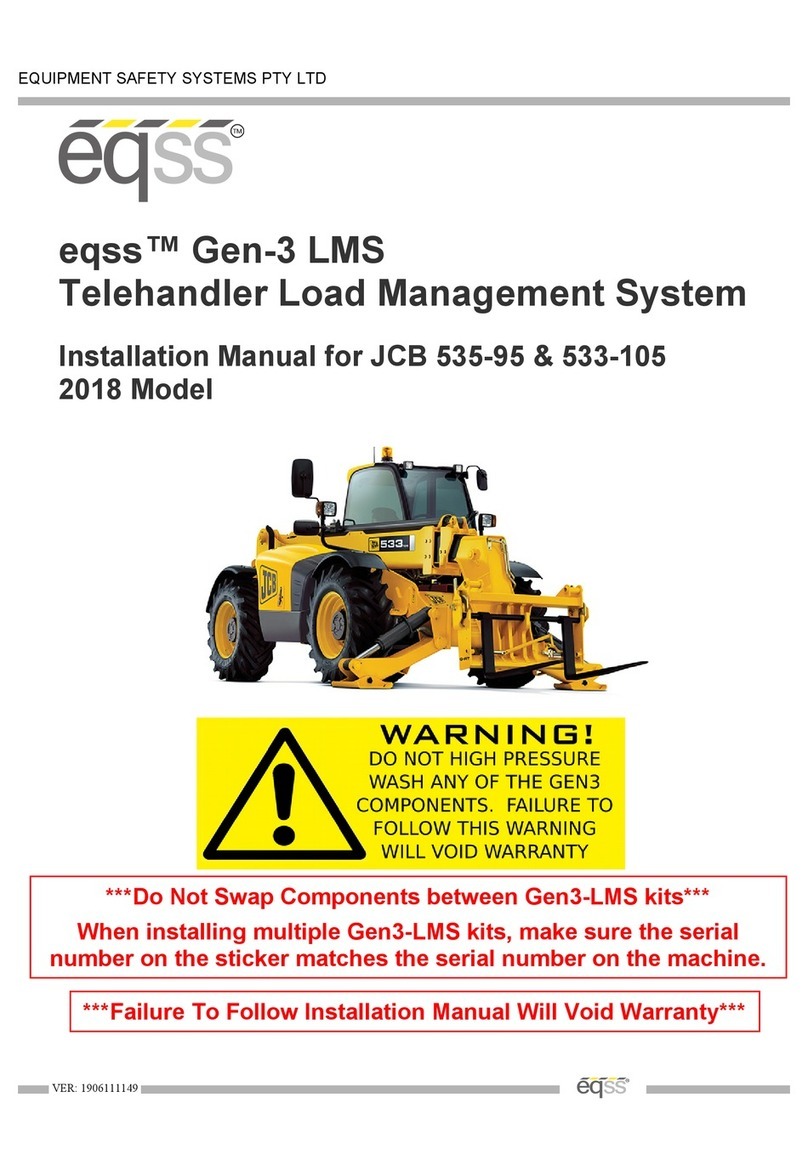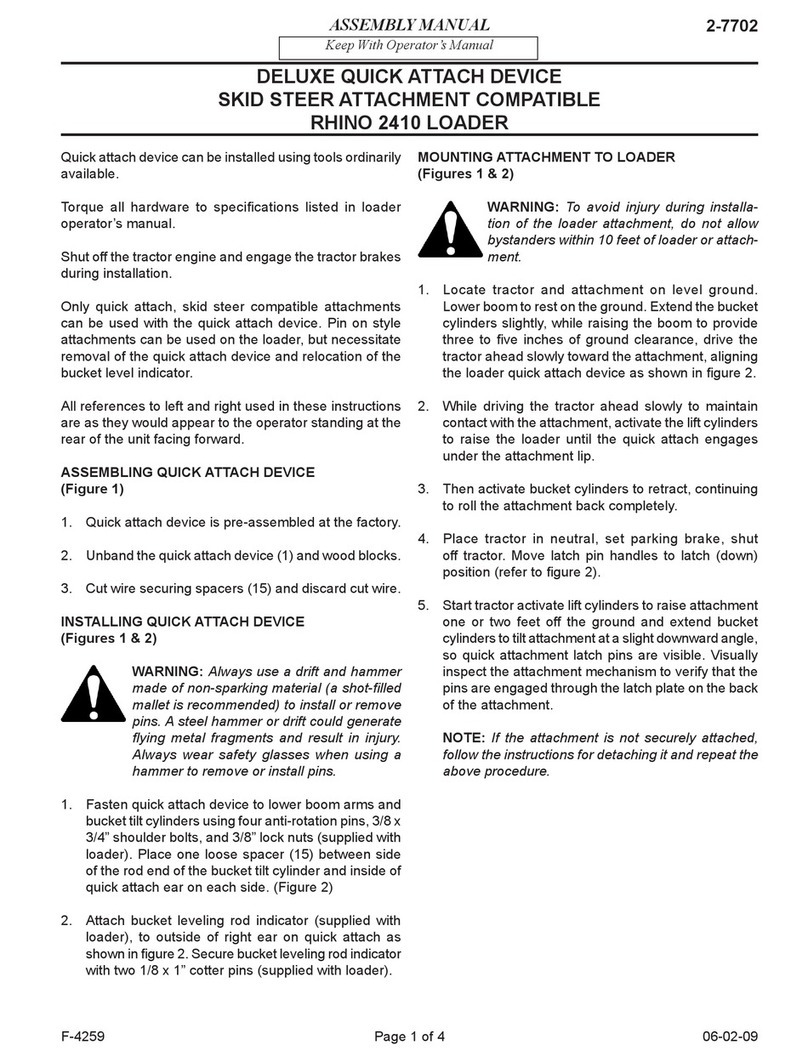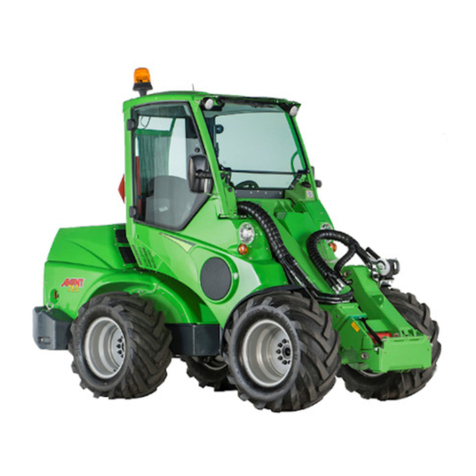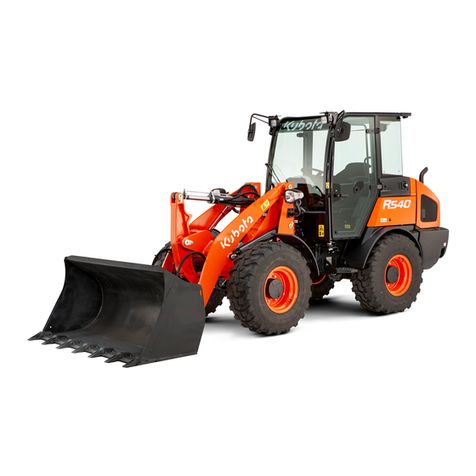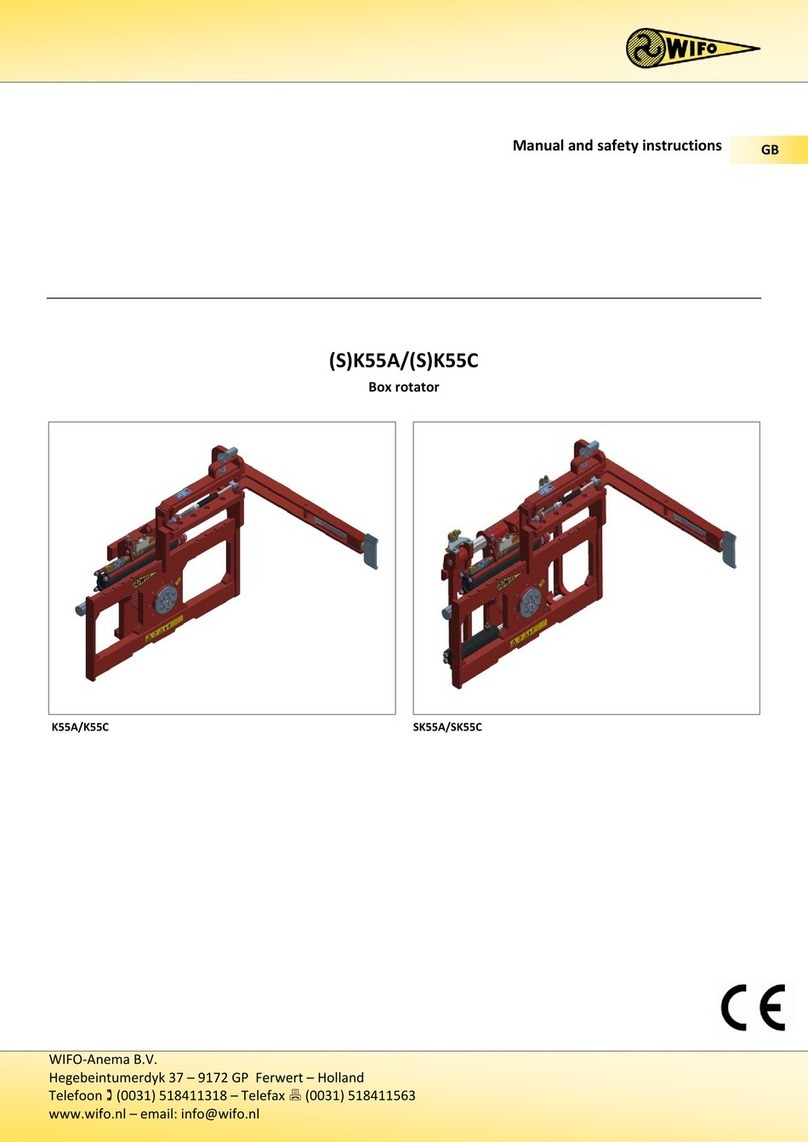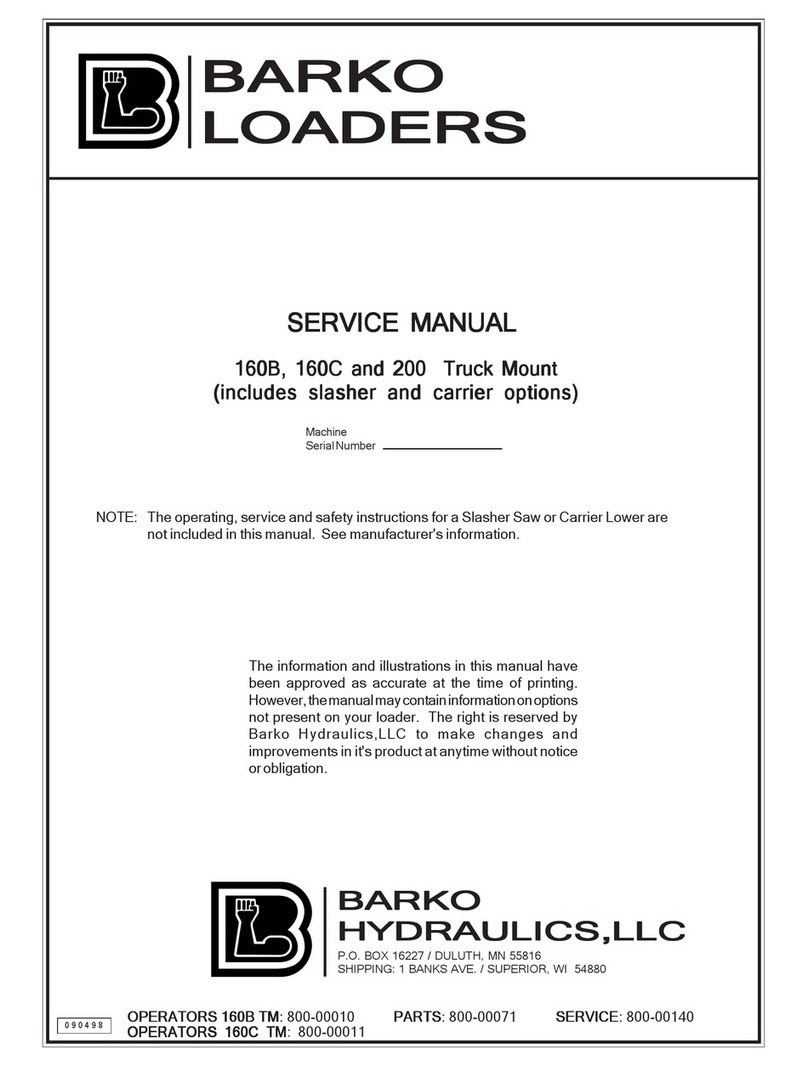Skytrak MMV Owner's manual

Keep this manual with the vehicle at all times.
8990504
OWNERS/OPERATORS
MANUAL
Model MMV
(S/N MV201 & After)
(Tier 2)
OM0652
TM 10794B-12/1
Printed in U.S
.A. 10/11
PCN 500 107943 00

WARNING: Improper operation of this vehicle can
cause injury or death. Only trained and authorized operators
should operate this vehicle.
Before starting the engine, do the following:
1. Read this owner/operators manual.
2. Read all the safety decals on the vehicle.
3. Clear the area of other persons.
Learn and practice safe use of vehicle controls in a safe,
clear area before you operate this vehicle on a worksite.
It is your responsibility to observe applicable laws and
regulations and to follow manufacturer's instructions on
vehicle operation and maintenance.
CALIFORNIA
Proposition 65 Warning
Diesel Engine exhaust and some of its constituents
are known to the State of California to cause
cancer, birth defects and other reproductive harm.
CALIFORNIA
Proposition 65 Warning
Battery posts, terminals and related accessories
contain lead and lead compounds, chemicals
known to the State of California to cause cancer
and birth defects or other reproductive harm.
Wash hands after handling.

Revision Log
a
8990504
Revision Log REVISION LOG
December 17, 2004 - B - Replaced all branding with JLG.
October 12, 2011 - C - Revised pages 22, 27, 66, 67, 70, 157, 170, 171, 182 thru
185, 193, 201, 218, 219, 221, 222 & 246.

Revision Log
b8990504

Table of Contents
1
This document has been prepared by JLG Industries Inc. for the USMC, 2004.
Approved for public release; distribution is unlimited.
Revision Log
Introduction
The Manual....................................2
Replacement Parts........................2
Reports..........................................2
Disclaimer......................................3
Safety Practices
Hazard Classification System........3
Accident Prevention Tags..............5
New or Additional Operators .........5
Instructional Symbols ....................6
Hazard Symbols............................7
Avoidance Symbols.......................8
Avoidance Symbols (cont’d)..........9
Personal Considerations .............10
Operational Considerations.........14
Equipment Considerations ..........20
Operation
Operator Controls........................23
Front Dash Panel.........................54
Instruments and Indicators..........61
Pre-Operation Inspection.............66
Normal Starting............................67
Cold Starting................................68
Slave Starting..............................70
Refueling .....................................71
Operating.....................................73
Carriages.....................................84
Using the Capacity Chart.............92
Load Capacity To Travel
Speed Tables ...........................94
Fork Rating................................104
How To Pick, Carry & Place
A Load....................................105
Elevating Personnel...................107
Shut-Off.....................................113
Emergency Operations
Towing a Disabled Vehicle........114
Emergency Boom Lowering ......123
General Maintenance
Introduction................................137
Maintenance Schedule and
Checklist.................................138
1. Lubrication Points ................141
2. Air Cleaner...........................143
3.Closed Cab Air Filters...........147
4.Engine Cooling System ........148
5.Engine Oil and Filter .............152
6.Engine Fuel System..............157
7.Engine Fan Belt....................162
8.Air Conditioner
Compressor Belt ...............163
9.Hydraulic Oil and Filter .........164
10.Transmission Oil
and Filter...........................169
11.Axle Oil ...............................172
12.Brake Disk Inspection.........175
13.Wheel End Oil.....................179
14.Transfer Case Oil................182
15.Wheels and Tires................186
16.Emergency Tire
Inflation System.................188
17.Batteries..............................192
18.Fuse & Relay
Replacement.....................194
19.Boom Chains and
Wear Pads ........................203
Storage and Transport ..............218
Short Term Storage...................218
Long Term Storage ...................220
Counterweight Removal
and Reassembly.....................223
Transport...................................226
Test Procedures
Stabil-TRAK™System Test ......236
Parking Brake/Transmission
De-Clutch
Test Procedures.....................241
Four Wheel Steer Indexing
Procedure...............................244
Specifications
Fluid & Lubrication Capacities...245
Tires ..........................................247
Weights .....................................248
Vehicle Dimensions...................249
Electrical System.......................250
Engine.......................................252
Index.............................................255
Accident Prevention Tags
Replacement Manuals...................1

2Model MMV Rev. 10/11
Introduction
Introduction
This Owners/Operators Manual provides the information you need to
operate and maintain this vehicle.
IMPORTANT! Before you operate this vehicle, read this manual completely
and carefully so you will understand the instructions and the operation of
the controls and equipment. You must comply with all Danger, Warning,
and Caution notices; they are for your benefit.
All references to the right side, left side, front, or rear are given from the
operator's seat looking forward.
For easy reference when ordering
replacement parts or making service
inquiries on this vehicle, record its
model and serial number on the back
cover of this manual. The serial
number is stamped into the serial
number plate (1) which is located on
the vehicle’s frame.
IMPORTANT! The replacement of
any part on this vehicle by anything
other than a JLG authorized
replacement part may adversely
affect the performance, durability or
safety of this vehicle and may void the warranty. JLG assumes no liability
for unauthorized replacement parts which adversely affect the performance,
durability or safety of this vehicle.
IMPORTANT! A Warranty Registration form must be filled out by the JLG
Authorized Service Center (ASC), signed by the purchaser, and returned to
JLG once the product is sold and/or put into service. This report activates
the warranty period, assuring that your claims during the warranty period
will be processed promptly. To guarantee full warranty service, make sure
your Authorized Service Center (ASC)has returned the business reply card
of this form to JLG.
The Manual
Replacement Parts
Reports
OM1370
1

Safety Practices
3
Model MMV Rev. 10/11
JLG reserves the right to make changes on and to add improvements upon
its products at any time without public notice or obligation. JLG also
reserves the right to discontinue manufacturing any product at its discretion
at any time.
NOTICE: Under OSHA rules, it is the responsibility of the employer to
provide operator training. Successful completion and certification of Safety
Training for Rough Terrain Forklifts is required. Operator Training Kits are
available by calling Ken Cook Company at (414) 466-6060. An order form
for these kits is available through our website,
http://www.jlg.com.
The information in this manual does not replace any safety rules and laws
used in your area. Before operating this vehicle, learn the rules and laws for
your area. Make sure the vehicle has the correct equipment according to
these rules and laws.
Your safety and the safety of others in the worksite depend significantly
upon your knowlege and understanding of all correct operating practices
and procedures for this vehicle.
Safety Practices
This safety alert symbol is used with the following signal words to attract
your attention to messages found within the manual and on hazard decals
located on the vehicle. They are reproduced herein and pertain to proper
operation and procedure messages contained throughout the manual. The
message that follows the symbol contains important information about
Safety. To avoid possible death or serious personal injury, carefully read
and follow the messages! Be sure to fully understand the potential causes
of death or injury.
Disclaimer
WARNING: DO NOT modify or alter (weld, drill, etc.)
any part of this vehicle without consulting JLG. Modifications can
weaken the structure creating a hazard that can cause death or
serious personal injury.
Hazard Classification System
OP0330

4Model MMV Rev. 10/11
Safety Practices
Signal Word
A signal word is a distinctive word located on hazard decals and used
throughout this manual that alerts the viewer to the existence of and relative
degree of the hazard.
The signal word “DANGER” indicates an imminently hazardous situation
which, if not avoided, will result in death or serious personal injury.
The signal word “WARNING” indicates a potentially hazardous situation
which, if not avoided, could result in death or serious personal injury.
The signal word “CAUTION” indicates a potentially hazardous situation
which, if not avoided, may result in minor or moderate injury.
The signal word “CAUTION”, used without the safety alert symbol, indicates
a potentially hazardous situation which, if not avoided, may result in
property damage.
For safe maintenance of the vehicle, read, understand and follow all
DANGER, WARNING and CAUTION information.
DANGER:
WARNING:
CAUTION:
CAUTION:

Safety Practices
5
Model MMV Rev. 10/11
Before beginning any maintenance or service, place an Accident
Prevention Tag (1) on both the ignition switch (2) and the steering wheel (3),
stating that the vehicle should not be operated. Actual Accident Prevention
Tags, which can be punched out and used, are included as the last page of
this manual. Retain these Accident Prevention Tags for reuse at a later
date.
At the time of original purchase, the purchaser of this vehicle was instructed
by the seller on its proper use. If this vehicle is to be used by an employee
or is loaned or rented to someone other than the purchaser, make certain
that the new operator is trained, in accordance with the OSHA regulations
referenced on page 3, and reads and understands this Operators Manual
before operating the vehicle.
In addition, make sure that the new operator has completed a walk-around
inspection of the vehicle, is familiar with all decals on the vehicle, and has
demonstrated the correct use of all controls.
Accident Prevention Tags
New or Additional Operators
DANGER
DANGER
OM1750
1
2
3

6Model MMV Rev. 10/11
Safety Practices
The following symbol definitions will help you understand all hazard
related decals used on this vehicle.
Instructional Symbols
OP0330
OH2100
OH2090
Safety Alert Symbol
Read Operator’s Manual
Fasten Seat Belt

Safety Practices
7
Model MMV Rev. 10/11
Hazard Symbols
-
OH2110
Lead Acid Batteries
Generate Explosive Gases
OH2120
OH2300
OH2161
OH2130
OH2140
OH2150
Rotating Fan Blades
Can Cut
Rotating Belts Can Cut
Or Entangle
Vehicle Tipover Can
Crush
Vehicle Roll Away Can Cause
Death Or Serious Injury
Electrocution Can
Cause Death Or
Serious Injury
FALLING OFF ATTACHMENT
Can Result In Death Or Serious
Injury
OH3160
OU1450
ENGINE EXPLOSION
Can Result In Death
Or Serious Injury
AVOID CRUSHING, Falling Off
Vehicle Can Cause Death Or
Serious Injury

8Model MMV Rev. 10/11
Safety Practices
Avoidance Symbols
OH2320
Keep Lit Cigarettes
Away
OH2310
OH2280
OH2330
OH2270
OH2290
Keep Away From
Rotating Fan Blades
Do Not Raise Boom
While On A Slope
Keep Flames and
Ignition Sources Away
Do Not Travel With
Boom Raised
Maintain Proper Air
Pressure In Tire
OU1460
DO NOT Use Ether Or
Other High Energy
Starting Aids.
Engine Equipped With
Grid Heating System.

Safety Practices
9
Model MMV Rev. 10/11
Avoidance Symbols (cont’d)
OH2260
Engage Parking Brake
OH2240
OH2220
OH2250
OH2230
OH2170
Do Not Travel With
Personnel In Work
Platform
DO NOT JUMP
Keep Clear Of Power
Lines
Carry No Riders
Use Only Compliant
Work Platforms To
Raise Or Lower
Personnel
• Brace Yourself and Stay
With Vehicle
• Keep Seat Belt Fastened
• Hold On Firmly
• Lean Away From The
Point Of Impact

10 Model MMV Rev. 10/11
Safety Practices
1. Seat Belt
Always fasten the seat belt before starting the engine.
2. Clothing and Safety Gear
DO NOT wear loose clothing or jewelry that can get caught on controls
or moving parts. Wear protective clothing and personal safety gear
issued or called for by job conditions.
3. Dismounting
DO NOT get off the vehicle until you:
•level the vehicle,
•ground the carriage,
•place the travel select lever in (N)
NEUTRAL,
•place the neutral lock lever in (N)
NEUTRAL LOCK,
•engage the parking brake switch,
•turn the engine off, if appropriate,
•unbuckle the seat belt,
•exit the vehicle using the hand holds.
4. Chemical Hazards
A. Exhaust Fumes
Fumes from the engine exhaust can cause death or serious
personal injury. DO NOT operate vehicle in an enclosed area
without a ventilation system capable of routing the hazardous
fumes outdoors.
B. Explosive Fuel
Engine fuel is flammable and can cause a fire and/or an explosion.
Avoid danger by keeping sparks, open flames and smoking
materials away from the vehicle and from fuel during refueling or
when servicing the fuel system. Know where fire extinguishers are
kept on the worksite and how to use them.
Personal Considerations
ALWAYS
engage parking brake
before dismounting
WARNING
VEHICLE
R LLAWAY
can cause
death or
serious
injury
OU0340

Safety Practices
11
Model MMV Rev. 10/11
C. Ether or High Energy Starting Aids
The engine utilizes a grid heating system inside the induction
manifold for cold starting conditions.
DO NOT use ether or any
other high energy starting
aids during cold starting. An
engine explosion can result
in death or serious personal
injury.
D. Hydraulic Fluid
DO NOT attempt to repair or tighten any hydraulic hoses or fittings
while the engine is running or when the hydraulic system is under
pressure. Fluid in the hydraulic system is under enough pressure
that it can penetrate the skin causing death or serious personal
injuries.
HOT HYDRAULIC FLUID WILL CAUSE SEVERE BURNS. Wait
for fluid to cool down before disconnecting lines.
DO NOT use your hand to check for leaks. Use a piece of
cardboard or paper to search for leaks. Wear gloves to protect
hands from spraying fluid.
Hydraulic fluid can cause permanent eye injury. Wear appropriate
eye protection and stop engine. Relieve pressure before
disconnecting lines. Pressure can typically be relieved by slowly
and cautiously loosening one end of a hose at the swivel
connection.
If anyone is injured by or if any hydraulic fluid is injected into the
skin, obtain medical attention immediately or gangrene may result.
WARNING: This diesel engine uses a grid heating sys-
tem inside the induction manifold. DO NOT use ether or any high
energy fuels to assist starting. An explosion may cause death or
serious personal injury or engine damage.
4110460
ENGINE EXPLOSION can
result in death or serious
personal injury.
DO NOT use Ether or other
high energy starting aids.
Engine e uipped with
grid heating system.
OU1470

12 Model MMV Rev. 10/11
Safety Practices
E. Batteries
The following WARNING is intended to supplement and does not
replace the warnings and information provided on the batteries by
the battery manufacturer.
When slave starting the vehicle, carefully follow instructions found
under “Slave Starting” on page 70.
Keep sparks, flames and lit smoking materials away from the
batteries at all times. Lead acid batteries generate explosive
gases. Severe chemical burns can result from improper handling of
battery electrolyte. Wear safety glasses and proper protective gear
when handling batteries to prevent electrolyte from coming in
contact with eyes, skin or clothing.
-
OS0621
Battery Electrolyte First Aid:
• External Contact — Flush with water.
• Eyes — Flush with water for at least 15 minutes and
get medical attention immediately.
• Internal Contact — Drink large quantities of water. Follow
with Milk of Magnesia, beaten egg or vegetable oil.
Get medical attention immediately.
IMPORTANT! In case of internal contact, DO NOT give fluids that
would induce vomiting!

Safety Practices
13
Model MMV Rev. 10/11
5. Moving Parts Hazard
DO NOT place limbs near moving parts. Severing of any body part can
result.
Turn off engine and wait until fan and belts stop moving before
servicing.
6. Lowering Boom or Falling Load Hazard
DO NOT get under a raised boom unless it is blocked up safely. Always
empty the attachment of any load and block the boom up before doing
any servicing that would require the boom to be raised.
NEVER allow anyone to walk or stand under the boom. A lowering
boom or falling load can result in death or serious personal injury.
MOVING PARTS can cut.
Keep clear of fan and belts
while engine is running.
MOVING PARTS can entangle.
OT0810

14 Model MMV Rev. 10/11
Safety Practices
1. Preparation and Prevention
Know the location and function of all vehicle controls.
Make sure all persons are away from the vehicle and that the travel
select lever is in the (N) NEUTRAL position and the Neutral Lock Lever
is in the (N) NEUTRAL LOCK position with the parking brake switch
engaged before starting the engine.
Holes, obstructions, debris and other worksite hazards can cause death
or serious personal injury. Always walk around and look for these and
other hazards before operating the vehicle in a new worksite.
Prevent accidents when you move the vehicle around the worksite.
Know the rules for movement of people and vehicles on the worksite.
Have a person act as a lookout for you. Follow the instructions of
signals and signs.
DO NOT operate the vehicle unless all hazard and instructional decals
are in place and readable. (Replace all missing, illegible, or damaged
decals.)
2. Clearances
Look out for and avoid other personnel, machinery and vehicles in the
area. Use a spotter if you do not have a clear view of conditions that
affect clearances. Travel with the boom fully retracted and lowered as
far as possible while still maintaining enough ground clearance for
conditions.
Always check boom clearances carefully before driving underneath
door openings, bridges, etc.
Always check for power lines when raising the boom. Beware of
overhead wires. Contact with electrical power lines can result in
electrocution. See “Electrocution Hazards” on page 15.
3. Visual Obstruction
Dust, smoke, fog, etc. can decrease vision and cause an accident.
Always stop or slow the vehicle until the obstruction clears and the
worksite is visible again. Have a lookout person assist you.
Where the load will obstruct the operator’s vision, it is recommended
that the vehicle be operated in REVERSE, looking backwards in the
direction of travel. Travel at a slower speed and get someone to direct
you.
Operational Considerations

Safety Practices
15
Model MMV Rev. 10/11
4. Underground Hazards
Know the location of all underground hazards before operating this
vehicle in a new area or worksite. Electrical cables, gas and water
pipes, sewer, or other underground objects can cause death or serious
personal injury. Contact your local underground utility service or diggers
hotline to mark all underground hazards.
5. Electrocution Hazards
NEVER operate this vehicle in an area where overhead power lines,
overhead or underground cables, or other power sources may exist
without first requesting that the appropriate power or utility company de-
energize the lines, or take other suitable precautions.
OS0063

16 Model MMV Rev. 10/11
Safety Practices
6. Elevating Personnel
Use only a compliant work platform meeting the ASME B56.6 standards
for lifting and lowering personnel. NEVER transport personnel in a work
platform for even the shortest distance.
Death or serious personal injury can occur if these rules are not
obeyed. Riders can fall and be crushed or run over. Avoid accidents.
For other specific precautions, See “Elevating Personnel” on page 107..
WARNING
Allow no riders
AV ID
CRUSHING,
falling off
vehicle can
cause death
or serious
injury
FALLING OFF ATTACHMENT,
can result in death or
serious injury.
DO NOT TRAVEL
with personnel in
a work platform.
4110389
Lift or lower personnel
only in a compliant
work platform.
WARNING
OU0620
OH3180
Table of contents
